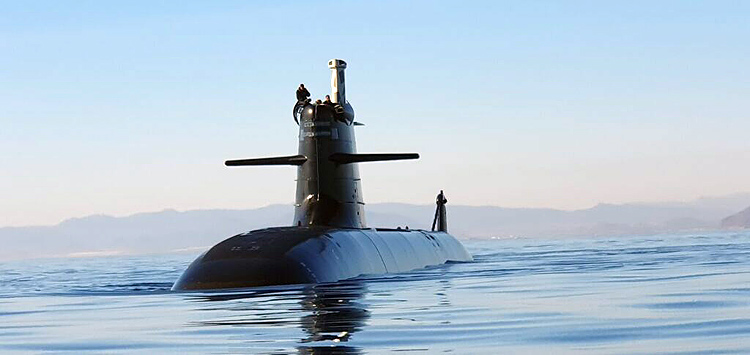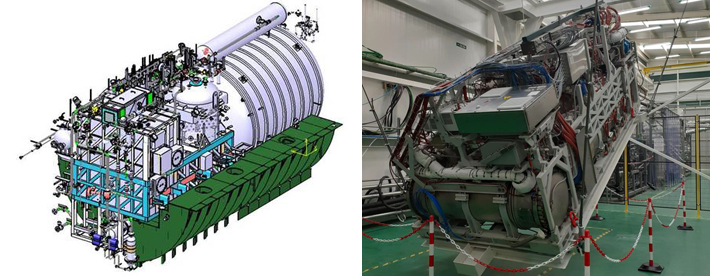INDIAN ARMED FORCES CHIEFS ON OUR RELENTLESS AND FOCUSED PUBLISHING EFFORTS

The insightful articles, inspiring narrations and analytical perspectives presented by the Editorial Team, establish an alluring connect with the reader. My compliments and best wishes to SP Guide Publications.

"Over the past 60 years, the growth of SP Guide Publications has mirrored the rising stature of Indian Navy. Its well-researched and informative magazines on Defence and Aerospace sector have served to shape an educated opinion of our military personnel, policy makers and the public alike. I wish SP's Publication team continued success, fair winds and following seas in all future endeavour!"

Since, its inception in 1964, SP Guide Publications has consistently demonstrated commitment to high-quality journalism in the aerospace and defence sectors, earning a well-deserved reputation as Asia's largest media house in this domain. I wish SP Guide Publications continued success in its pursuit of excellence.
- Prime Minister Modi Visits Punjab’s Adampur Air Base, Interacts with Airmen after Successful ‘Operation Sindoor’; Stern Message to Pakistan
- The layered Air Defence systems that worked superbly, the key element of Operation Sindoor
- Operation Sindoor | Day 2 DGMOs Briefing
- Operation Sindoor: India strikes back with Precision and Purpose
- Operation Sindoor: Resolute yet Restrained
- India’s Operation Sindoor Sends a Clear Message to Terror and the World – ‘ZERO TOLERANCE’
- Japan and India set forth a defence cooperation consultancy framework, talks on tank and jet engines
- Terrorist Attack in Pahalgam in Kashmir: Unfolding a long surgical war against PAK
- Lt General Pratik Sharma takes over Command of Indian Army's Northern Command
The Final Countdown to the Making of Project-75(I): Navy inspects Spain's submarine offered for the Programme
The P-75(I) Submarine has progressed into the final stage with the Indian Navy's Field Evaluation Trials based on Navantia's S-80 class submarine in Spain. What it offers to India, revolves around its AIP systems, with the possibility of NATO weapons for unique firepower, including submarine cruise missiles, loaded on the S-80s.


The Indian Navy recently completed its evaluation of Navantia's S-80 class submarine, a contender for India's Project-75(I), a programme to indigenously build six next-generation submarines, in Cartagena, Spain.
The Navy's mega-submarine deal under Project-75(I), expected to be valued at over Euro 4.8 billion (₹43,000 crore), has progressed towards the final phase with the completion of the Field Evaluation Trials (FET). The FET is the penultimate but the most critical stage of the submarine bidding process which ensures that all the elements of the bids and compliances are on par and in accordance with the tender issued and submissions by the Indian Strategic Partners (SP) based on Design from Foreign Original Equipment Manufacturers (FOEM).
Indian Navy recently completed its evaluation of Navantia's S-80 class submarine, a contender for India's Project-75(I) programme to indigenously build six next-generation submarines.
There are two contenders in the fray: MDL with Germany's TKMS (Thyssenkrupp Marine Systems) and L&T with Navantia of Spain. The project is India's largest defence acquisition project. This would also be followed by a 30-year lifecycle sustenance contract with the winner of the Programme.
While key elements of P-75(I) submarines seek to build indigenous capacity in the domestic private defence industry through the Strategic Partnerships Model (SPM), the MoD allowed MDL a state-owned defence major to also participate. The Project also highlights the greater tech integration in collaboration with foreign partners.
The Navy's mega-submarine deal under Project-75(I), expected to be valued at over Euro 4.8 billion (₹43,000 crore), has progressed towards the final phase with the completion of the Field Evaluation Trials (FET).
Thus, the RFP under SPM for the P-75(I) mandates the Indian bidders to tie up with a FOEM partner and execute the programme in India incorporating Air-Independent Propulsion (AIP) while achieving targeted Indigenous Content.
Earlier, the Indian Navy had already concluded the FET at the TKMS shipyard at Kiel in Germany in March 2024. Germany has offered readiness for a government-to-government proposal to India for the sale of six submarines. Germany has offered submarines based on Class 214 and Class 212CD designs.
Nex-Gen Submarine: A Partnership proposition
Last year, in April, Indian engineering conglomerate, Larsen & Toubro and Navantia concluded a Teaming Agreement (TA) for the purpose of submission of a techno-commercial bid for the Indian Navy's prestigious P-75(India) submarine programme. L&T, which has completed many hi-stake military projects, including the K-9 Vajra Howitzer for the Indian Army, is also understood to be involved in India's strategic nuclear submarine projects.
In this case, Navantia would be sharing the design of P-75(I) submarines based on its 3,000-tonne S-80 class of submarines for the Spanish navy, the first of which was launched in 2021. Spain commissioned its first S-80 Plus-class submarine, the Isaac Peral, on November 30, 2023. S-80 Plus are designed for longer-range missions and would mature as the first Spanish boats fitted with AIP for extended underwater endurance.
The S-80 does add attack capabilities including heavy-weight torpedoes, mines submarine-launched anti-ship and cruise missiles, etc. The range of weapons which is tested on the S-80 is notably DM2A4 Heavy Weight Torpedo (and, varieties of NATO standard heavy torpedoes), a Sub-Harpoon Missile Fitted for Tomahawk Missile with Torpedo countermeasures system. Additionally, the S-80's attack capabilities also include the capacity to launch submarine cruise missiles (SLCM) which is somehow unique for non-nuclear NATO submarines.
There are two contenders in the fray: MDL with Germany's TKMS (Thyssenkrupp Marine Systems) and L&T with Navantia of Spain.
S-80 class is also packed with advanced intelligent naval mines currently in production and three different models for different depths and characteristics of the waters: moored mines, low-profile mines, and cylindrical mines. In next-generation submarines today, that takes place with sensors and processors which detect magnetic, electric, acoustic, pressure, and seismic influences.
Notably, Navantia bringing the Spanish heritage of nearly three centuries of submarine building is not new to the Indian defence ecosystems. Navantia has played a significant role in the existing Scorpéne class of submarines which is largely executed by the French entity, Naval Group with an Indian Public sector defence company, MDL based in Mumbai. Earlier, Navantia was a co-designer and participated in the transfer of technology of India's six Scorpene submarines, deploying a sizeable resident team in India between 2006 and 2013 to help MDL build the Scorpéne submarines.
P-75(I): The criticality of the AIP-based submarine
P-75(I) would be the first such initiative under the ambitious SPM model of acquisition. As mandated, the project calls for integration of an AIP system for enhanced submerged endurance.
It is understood that Navantia's 3rd Generation AIP solution is the latest and one of the most advanced AIP systems in the world, apart from being the most compact, easy to exploit & maintain while being environment friendly. It uses bioethanol as a source for generating hydrogen which is known to be cost-efficient, easily available, and not requiring any special infrastructure.

Importantly, the key aspect of bringing higher power density on board is achieved by using Bio-Ethanol Stealth Technology (BEST) which produces hydrogen on demand from liquid fuel such as Bio-Ethanol stored in conventional structural tanks at room temperature and pressure. The high mass percentage of hydrogen in ethanol (multiple times higher hydrogen content than 2nd generation AIPs) improves the AIP system's efficiency. Ethanol, being in liquid form, eliminates the risks associated with storing hydrogen. Moreover, the wide and easy availability of ethanol enables the system to be refuelled anywhere in the world without any logistical difficulties. As estimated, the AIP on the S-80 Plus, while submerged, can cater for quiet underwater cruising for three weeks at 4 knots.
The thrust on Green AIP solution is also highlighted by S.N. Subrahmanyan, CEO & MD, L&T as the most plausible and advanced solution. Subrahmanyan, in an interaction, last year in September, had said: "We are committed to providing the most contemporary solution for the Indian Navy's requirements at a competitive price," he further added in terms of overall price advantage. Moreover, the wide availability of ethanol enables the system to be refuelled anywhere in the world. "
The project calls for the integration of an Air-Independent Propulsion (AIP) system for enhanced submerged endurance and Navantia's 3rd Generation AIP solution is considered one of the most advanced in the world.
Another key element, which S-80 incorporates, is exploiting the capabilities of proven Lithium-Ion Batteries which provide higher volumetric and gravimetric energy density as compared to lead-acid batteries. However, it requires a much higher degree of precautions for safety and is costlier than conventional low-power density lead-acid batteries.
What also adds to the indigenous elements in the context of AIP is the similar efforts to develop and integrate AIP with the existing Socrpene-class of the submarine which is underway by the Defence Research and Development Organisation (DRDO). Here, L&T is also the industry development partner with DRDO to integrate indigenously developed AIP after rigorous tests and certifications. The idea stems from the need for a larger number of conventional submarines fitted with AIP which can be utilised in the Indian Ocean Region and beyond to the Pacific for surveillance in the wake of the increasing number of Chinese submarines in the area.
On another front, Pakistan has already moved ahead with the acquisition of eight 039 Yuan class submarines from China with AIP capability by 2028. Multiple conflicts in the sea have widely extended the role of the Indian Navy in the Indo-Pacific.
A few Challenges that lie ahead
However, the already delayed process through the much-lauded Strategic Partnership still faces some challenges.
Firstly, it stems from the very requirement of an AIP system integrated with the submarine which must be running and operational. What this also entails is the qualification and certification of the sea-worthiness along with the successful test of the AIP systems. Navantia's 'BEST' AIP systems' capabilities assessed as part of the FET conducted at Cartagena shipyard through have to be evaluated for long-tenure and operational mission profiles with a fully automated and operational AIP power plant. On the other hand, the TKMS-led AIP-based submarine is an over two-decade-old technology but offers such certification readily.
Secondly, in most of the G-to-G defence deals, contentious issues do circle on governmental guarantees on behalf of the participating entities. According to Navatia's stated position, it is a state-owned enterprise and offers a full commitment to the Transfer of Technology (ToT) based on state approvals thereby guaranteeing sovereignty to the Indian side in national defence.
This brings L&T and Navantia, a step closer to the final countdown for India's most ambitious indigenous submarine programme. As per the former naval chief who spoke with the author, the competition [between TKMS and Navantia] will bring justice to such a massive project, in terms of cost and scale, that the Indian Navy is embarking on.
Manish Kumar Jha is a Consulting & Contributing Editor for SP's Aviation, SP's Land Forces and SP's Naval Forces and a security expert. He writes on national security, military technology, strategic affairs & policies.





